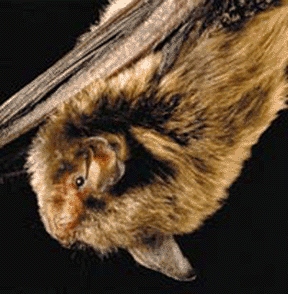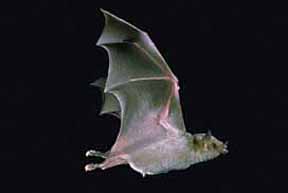List Of U.S. State Bats on:
[Wikipedia]
[Google]
[Amazon]
Most of the many



 Bats belong to the biological order of
Bats belong to the biological order of
Bat facts
at the
Selected list of publications on bats
{{USStateLists *Bats
bat
Bats are mammals of the order Chiroptera.''cheir'', "hand" and πτερόν''pteron'', "wing". With their forelimbs adapted as wings, they are the only mammals capable of true and sustained flight. Bats are more agile in flight than most ...
species found in the United States
The United States of America (U.S.A. or USA), commonly known as the United States (U.S. or US) or America, is a country primarily located in North America. It consists of 50 states, a federal district, five major unincorporated territori ...
are insectivorous except for three flower eating species that migrate from Mexico and one that inhabits the Florida Keys.
__TOC__
Species



 Bats belong to the biological order of
Bats belong to the biological order of Chiroptera
Bats are mammals of the order Chiroptera.''cheir'', "hand" and πτερόν''pteron'', "wing". With their forelimbs adapted as wings, they are the only mammals capable of true and sustained flight. Bats are more agile in flight than most bir ...
. The bat families found in North America are Vespertilionidae
Vespertilionidae is a family of microbats, of the order Chiroptera, flying, insect-eating mammals variously described as the common, vesper, or simple nosed bats. The vespertilionid family is the most diverse and widely distributed of bat famili ...
, Molossidae, Mormoopidae
The family Mormoopidae contains bats known generally as mustached bats, ghost-faced bats, and naked-backed bats. They are found in the Americas from the Southwestern United States to Southeastern Brazil.
They are distinguished by the presenc ...
and Phyllostomidae.
Molossidae
* Florida bonneted bat ''Eumops floridanus'' * Wagner's bonneted bat ''Eumops glaucinis'' *Western mastiff bat
The western mastiff bat (''Eumops perotis''), also known as the western bonneted bat, the greater mastiff bat, or the greater bonneted bat, is a member of the free-tailed bat family, Molossidae. It is found in the Western United States, Mexico a ...
''Eumops perotis''
* Underwood's bonneted bat ''Eumops underwoodi''
* Velvety free-tailed bat ''Molossus molossus''
* Pocketed free-tailed bat ''Nyctinomops femorosaccus''
* Big free-tailed bat ''Nyctinomops macrotis''
*Mexican free-tailed bat
The Mexican free-tailed bat or Brazilian free-tailed bat (''Tadarida brasiliensis'') is a medium-sized bat native to the Americas, so named because its tail can be almost half its total length and is not attached to its uropatagium. It has been ...
''Tadarida brasiliensis''
Mormoopidae
*Ghost-faced bat
The ghost-faced bat (''Mormoops megalophylla'') is a bat in the genus ''Mormoops''. It is one of only two extant species within its genus, the other being the much smaller ''Mormoops blainvillii''. They are nocturnal and hunt using Animal echolo ...
''Mormoops megalophylla''
Phyllostomidae
*Jamaican fruit bat
The Jamaican, common or Mexican fruit bat (''Artibeus jamaicensis'') is a fruit-eating bat native to Mexico, through Central America to northwestern South America, as well as the Greater and many of the Lesser Antilles. It is also an uncommon re ...
''Artibeus jamaicensis'' (Florida Keys only)
*Mexican long-tongued bat
The Mexican long-tongued bat (''Choeronycteris mexicana'') is a species of bat in the family Phyllostomidae. It is the only species within the genus ''Choeronycteris''. The species is found in El Salvador, Guatemala, Honduras, Mexico, and th ...
''Choeronycteris mexicana''
*Mexican long-nosed bat
The greater long-nosed bat or Mexican long-nosed bat (''Leptonycteris nivalis'') is a species of bat in the family Phyllostomidae. It is found in Mexico and the United States. It chiefly consumes pollen and nectar, particularly from agave plan ...
''Leptonycteris nivalis''
*California leaf-nosed bat
The California leaf-nosed bat (''Macrotus californicus'') is a species of bat in the family Phyllostomidae. It is found in Mexico and the United States. Its natural habitat is hot deserts.
Habitat
California leaf-nosed bats can be found in ...
''Macrotus californicus''
Vespertilionidae
* Pallid bat ''Antrozous pallidus'' * Rafinesque's big-eared bat ''Corynorhinus rafinesquii'' *Townsend's big-eared bat
Townsend's big-eared bat (''Corynorhinus townsendii'') is a species of vesper bat.
Description
Townsend's big-eared bat is a medium-sized bat (7-12 g)
''Corynorhinus townsendii''
*Big brown bat
The big brown bat (''Eptesicus fuscus'') is a species of vesper bat distributed widely throughout North America, the Caribbean, and the northern portion of South America. It was first described as a species in 1796. Compared to other microbat ...
''Eptesicus fuscus''
* Spotted bat ''Euderma maculatum''
* Allen's big-eared bat ''Idionycteris phyllotis''
*Silver-haired bat
The silver-haired bat (''Lasionycteris noctivagans'') is a solitary migratory species of vesper bat in the family Vespertilionidae and the only member of the genus ''Lasionycteris''.
Etymology
The species name translates as night-wandering, ref ...
''Lasionycteris noctivagans''
*Western red bat
The western red bat or desert red bat (''Lasiurus frantzii'') is a species of microbat in the family Vespertilionidae. It is found in western North America and Central America.
Taxonomy
Previously, it was believed to be a subspecies of the ...
''Lasiurus blossevillii''
* Eastern red bat ''Lasiurus borealis''
* Hoary bat ''Lasiurus cinereus''
* Southern yellow bat ''Lasiurus ega''
* Seminole bat ''Lasiurus seminolus''
* Southwestern myotis ''Myotis auriculus''
* Southeastern myotis ''Myotis austroriparius''
*California myotis
The California myotis (''Myotis californicus'') is a species of vesper bat. It is found in British Columbia in Canada, Guatemala, Mexico, and in the western United States, including California.
Description
The California myotis is a small (70– ...
''Myotis californicus''
* Western small-footed myotis ''Myotis ciliolabrum''
*Long-eared myotis
The long-eared myotis (''Myotis evotis'') is a species of vesper bat in the suborder Microchiroptera. It can be found in western Canada, the western United States, and Baja California in Mexico.
Description
The long-eared myotis is a pale brown ...
''Myotis evotis''
* Gray bat ''Myotis grisescens''
* Keen's myotis ''Myotis keenii''
* Eastern small-footed myotis ''Myotis leibii''
*Little brown bat
The little brown bat or little brown myotis (''Myotis lucifugus'') is an endangered species of mouse-eared microbat found in North America. It has a small body size and glossy brown fur. It is similar in appearance to several other mouse-ea ...
''Myotis lucifugus''
* Arizona myotis ''Myotis occultus''
* Northern long-eared myotis ''Myotis septentrionalis''
*Indiana bat
The Indiana bat (''Myotis sodalis'') is a medium-sized mouse-eared bat native to North America. It lives primarily in Southern and Midwestern U.S. states and is listed as an endangered species. The Indiana bat is grey, black, or chestnut in colo ...
''Myotis sodalis''
* Fringed myotis ''Myotis thysanodes''
* Cave myotis ''Myotis velifer''
*Long-legged myotis
The long-legged myotis (''Myotis volans'') is a species of vesper bat that can be found in western Canada, Mexico, and the western United States.
Description
''Myotis volans'' is a species of bat found in Order Chiroptera, Family Vespertillion ...
''Myotis volans''
* Yuma myotis ''Myotis yumanensis''
*Evening bat
The evening bat (''Nycticeius humeralis'') is a species of bat in the vesper bat family that is native to North America. Hunting at night, they eat beetles, moths, and other flying insects.
Description
The evening bat is a small bat weighi ...
''Nycticeius humeralis''
* Canyon bat ''Parastrellus hesperus''
*Tricolored bat
The tricolored bat (''Perimyotis subflavus'') is a species of microbat native to eastern North America. Formerly known as the eastern pipistrelle, based on the incorrect belief that it was closely related to European '' Pipistrellus'' species, t ...
''Perimyotis subflavus''
Notable bat roosts
In 2009 the Grandview Mine in the Grand Canyon National Park had gates added to support on-going bat research, preserve historic mine resources, and promote visitor safety. The Ann W. Richards Congress Avenue Bridge, which crosses over Lady Bird Lake in Austin, Texas, is the world's largest urban bat colony. Seventeen species of bats live in theCarlsbad Caverns National Park
Carlsbad Caverns National Park is an American national park in the Guadalupe Mountains of southeastern New Mexico. The primary attraction of the park is the show cave Carlsbad Cavern. Visitors to the cave can hike in on their own via the natural ...
, including a large number of Mexican free-tailed bat
The Mexican free-tailed bat or Brazilian free-tailed bat (''Tadarida brasiliensis'') is a medium-sized bat native to the Americas, so named because its tail can be almost half its total length and is not attached to its uropatagium. It has been ...
s. It has been estimated that the population of Mexican free-tailed bats once numbered in the millions but has declined drastically in modern times. The cause of this decline is unknown but the pesticide DDT
Dichlorodiphenyltrichloroethane, commonly known as DDT, is a colorless, tasteless, and almost odorless crystalline chemical compound, an organochloride. Originally developed as an insecticide, it became infamous for its environmental impacts. ...
is often listed as a primary cause.
State insignia
As of February 2011, at least three states had an official bat. Hawai'i named the Hawaiian hoary bat as the official state land mammal in April 2015. The general assembly ofNorth Carolina
North Carolina () is a state in the Southeastern region of the United States. The state is the 28th largest and 9th-most populous of the United States. It is bordered by Virginia to the north, the Atlantic Ocean to the east, Georgia and ...
considered a bill in 2007 that would have made Rafinesque's big-eared bat as its state bat. The bill passed 92-15, but died in the state senate.
See also
*Environment of the United States
The environment of the United States comprises diverse biotas, climates, and geologies. This diversity leads to a number of different distinct regions and geographies in which human communities live. This includes a rich variety of species of both ...
References
External links
Bat facts
at the
Smithsonian Institution
The Smithsonian Institution ( ), or simply the Smithsonian, is a group of museums and education and research centers, the largest such complex in the world, created by the U.S. government "for the increase and diffusion of knowledge". Founded ...
Selected list of publications on bats
{{USStateLists *Bats